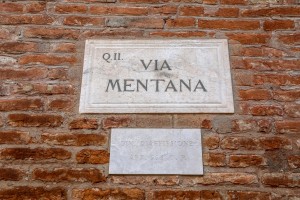Via Mentana
Name and brief history
Carlo Bassi describes this road as one of the most important in the plan for the Erculean Addition, along with Via Bellaria, Via Mascheraio and others. Historically it was called Via Colonna: ‘perhaps after the Pharmacy of the Column or the Two Columns, which was open until 1515; or, more likely, after the noble Colonna family. Alessandro Colonna in fact owned the beautiful Palazzino dei Pasetti, once Counts Bernardi and Zuffi, on the corner at Via Cortevecchia’ (G. Melchiorri, Nomenclatura ed Etimologia delle Piazze e delle Strade di Ferrara e Ampliamenti all’Opera di Gerolamo Melchiorri, edited by C. Bassi, 2G Editrice, Ferrara 2009, p. 93). In 1905, it was given its present-day name of Via Mentana, in reference to the battle of the same name fought by Garibaldi on 3 November 1867 against Papal Rome.
In literature
Giorgio Bassani located the house of Edgardo Limentani, protagonist of The Heron, at 2 Via Mentana. In the novel, Limentani lives in a refined building, saved in 1938 by a marriage of convenience with a Catholic woman. To the fictional character and his family, in addition to Ferrara and Italy in real life, 1938 was a watershed year. From the start of the novel, the darkness that enshrouds the street, the building and its elements seem almost foreboding of the protagonist’s tragic decision to commit suicide [from the third chapter: ‘He leaned down to brush his lips against the little girl’s forehead, retraced his steps across the room, and went out a third time into the corridor. He turned on the light switch and looked at the time. It was five minutes past five. He went back to pick up the rifle hanging on the window-handle, slung it over his left shoulder, and went on his way. And soon after, with the sensation of falling into a well, slowly, and without any sign of haste, he descended the dark spiral staircase which led down to the entrance. (G. Bassani, ‘The Heron’, in The Novel of Ferrara, Translated by Jamie McKendrick, Penguin Classics, 2018, e-book location 9097)’].
Quotes
‘Neither she [Imelda - Ed.] nor Romeo could stand Nives. More or less openly, they showed their disapproval of everything to do with her, and extended their censure to include Prearo, the accountant, as well as the cook, Elsa, and even Rory – in short, every new person or thing that had made an appearance at no. 2 Via Mentana since 1938. Whenever they spoke to him about her, they never used her name. Unfailingly they called her ‘your Signora’, the only true ladies of the house being ‘Signora Erminia’, and Lilla, the three-year-old poodle who was his mother’s tender companion, and was even allowed in her bed, her only true child to cuddle and spoil in every possible way. They had nothing in the least bit good to say about Nives, ever.’ (G. Bassani, ‘The Heron’, in The Novel of Ferrara, translated by Jamie McKendrick, Penguin Classics, 2018, e-book location 9138) ‘The moon lit up the entire length of Via Montebello from the Giovecca crossing right down to the distant, massive, greyish granite arcade sited at the entrance to the Jewish Cemetery. Via Mentana, however, was almost in darkness. As soon as he’d turned the corner, he switched the headlights on full beam. The gates were wide open. In front of them, Romeo was standing, waiting calmly at the curb, with his beret, his grey woollen scarf wrapped round his neck and his hands sunk in his trouser pockets.’ (G. Bassani, ‘The Heron’, in The Novel of Ferrara, translated by Jamie McKendrick, Penguin Classics, 2018, e-book location 10584)
Bibliography
Compiling entity
- Assessorato alla Cultura e al Turismo, Comune di Ferrara
Author
- Barbara Pizzo

